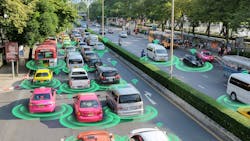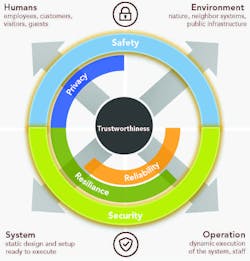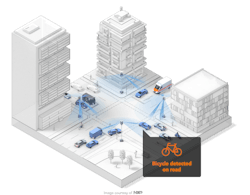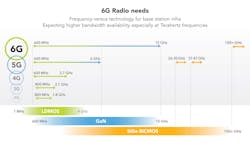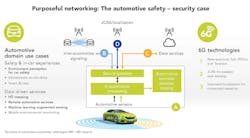6G: An Automotive Perspective
What You’ll Learn:
- How 6G is impacting the automotive industry.
- 6G features that present new opportunities for vehicle safety and services.
Today’s connected world is all about interacting through, with, and among an ever-increasing range of smart devices. The global hunger for more bandwidth and lower latency has driven the emergence of the first wave of 5G and Wi-Fi 6/7 connectivity. Researchers are looking at what’s next with development underway on the second and third waves of 5G systems.
This article looks at one specific use case: automotive. The automotive industry is innovating rapidly through electrification and automation, coinciding with 5G evolution and 6G research in the communications industry. System and product targets across both sectors are aligned beyond the well-understood performance and latency metrics, with situational awareness, safety, and security being solid examples.
Developments and Challenges in Connected Autonomous Driving
In recent years, the evolution of the electric vehicle (EV)—electrification—has grabbed the headlines. However, innovation in automotive technology extends well beyond the means of propulsion to cover a broad range of vehicular capabilities. Developers and manufacturers also focus their activities on driver assistance and car connectivity.
Enhancements, such as radar for advanced driver-assistance systems (ADAS) capabilities, engine and driver/passenger observability and control functions, and battery management for EV powertrains, go hand in hand with connectivity advances. These include cloud connectivity, infotainment, and enhanced vehicle-to-everything (V2X) connectivity functions.
Vehicle-to-Cloud
By providing ubiquitous connectivity, 5G is enabling the vehicle itself to become a connected entity. As cars become increasingly connected and software-oriented, vehicle-to-cloud (V2C) connectivity is enabling a greater range of operational and security functions.
Automotive OEMs can collect and store data, such as odometer readings, charge status, and mechanical information, to inform the owner of their vehicle status and provide automated alerts when maintenance is due. Software updates can be applied over the air (OTA) whenever a new feature or security patch is ready, removing the need for a visit to the garage.
Opportunities to improve the vehicle’s performance over time become endless. The car is becoming subject to continuous software-driven product updates and enhancements that provide an improving consumer experience over time. It extends the lifetime of the vehicle, and this alone brings important environmental benefits.
Automotive Infotainment, Smart Access, and Mobility
Anyone who has taken their family on a long road trip understands the value of in-car infotainment systems. Consumer-accessible technology and improved connectivity are transforming the in-car experience for both driver and passengers.
Touchscreen displays and voice-activated systems are replacing clunky CD players by offering access to multimedia, video streaming, 3D maps, and games. And charging stops are turned into productive working hours by providing in-car Wi-Fi connectivity.
Vehicle-to-Everything (V2X) Communications
The concept of V2X connectivity is about enabling vehicles to communicate with everything around them: other vehicles, infrastructure, traffic lights, parking spaces, and even other road users such as cyclists and pedestrians. With V2X, information from vehicle sensors can be shared with other entities via (wireless) communication links.
The aim is to improve driver awareness of obstacles and potential dangers, thereby reducing stress and accident rates. V2X also hastens traffic flow by giving an advanced warning (and mitigation options) of traffic congestion, intelligent speed assistance, and facilitating access to parking spaces.
These objectives are clear, but it’s important to understand the safety and security implications associated with these features—the implications of something going wrong are huge, as shown very publicly in examples where autonomous-driving systems have failed. The principle of trustworthiness (Fig. 1) dictates that the design of any ADAS architecture must incorporate adequate safety and security measures.
Consider the case of a complex intersection (Fig. 2). A car’s onboard sensors, such as the camera and radar, only work in line-of-sight situations. Therefore, a vulnerable road user hidden by another vehicle, such as a cyclist, will not be visible.
Meeting the safety requirements of the trustworthiness model requires supporting technologies. For example, a V2X-enabled roadside infrastructure unit (“smart traffic light”) at the intersection and the cyclist’s smartphone can provide supplementary information that could be shared with the car to improve its situational awareness.
V2X Recipe
So, what are the engineering ingredients required to enable this use case? Obviously, we need high-reliability and ubiquitous connectivity as targeted for both 5G and 6G communication. All parties involved need to be connected or, at the very minimum, be within the detection/sensing range. Beyond that, we need an ecosystem that enables the various data streams to be shared and processed in a time-sensitive matter.
This is where we see 6G providing value: It can provide joint capabilities of both communication and sensing. In practice, this means that the communications network uses its radio capabilities to implement a sensing function.
It could be either very radar-like (a wireless telecommunication system and a radar incorporating very similar components and architectures) or through artificial intelligence (the wireless network knows you’re crossing the road to go to a coffee shop every weekday). As the wireless radio access network (RAN) becomes situationally aware, joint communication and sensing principles can be applied. The next step is to place this situational information at the most beneficial point in the network to increase safety.
The above examples vividly highlight how the application of the trustworthiness principle requires that privacy-sensitive data, including location and identity, as generated by the various parties in the scenario, is processed by a trustworthy compute platform.
Increasing the levels of autonomy requires complete integrity of the vehicle’s situational awareness, in all weather conditions and visibilities, as well as the ability to react to its environment within an appropriate timescale.
The scenario described above and the associated data requirements highlight the growing demands placed on 5G networks by the connected vehicle. It also gives an insight into the 6G vision.
The 6G Vision
As we explore the “automotive angle” to (wireless) networking to realize the full potential of the connected car, let’s delve into how the 6G vision is taking shape as a technology that underpins its promise of enhanced network capacity, reliability, and intelligence.
Continuing the trend of wireless communication utilizing higher and higher frequency bands to unlock higher channel bandwidths and data rates, 6G is predicted to extend the current 5G low-frequency bands up as far as 24 GHz. Most interest is in the mid-band or centimetric spectrum range at 6 to 20 GHz. Beyond that, the millimeter-wave (mmWave) bands up to the terahertz frequencies (100 GHz and higher) are of significant interest since wider chunks of bandwidth can potentially be used (Fig. 3).
The shorter wavelengths of mmWave and the terahertz spectrum bring further benefits, including reduced physical antenna sizes that enable new form factors and spatial diversity. Already used in 5G networks, spatial diversity leverages multiple-input/multiple-output (MIMO) and beamforming architectures to transmit multiple narrow beams. All of the beams carry different data to multiple users simultaneously, making more effective use of the spectrum.
Increased network capacity is provided by network densification with the deployment of more base stations at hot-spot communication points. Here, signals are kept local, preventing interference with other cells.
One of the most innovative capabilities to emerge from the 6G specifications is integrated sensing. The sub-THz frequencies proposed for 6G require beamforming/MIMO to achieve acceptable coverage. The implementation of a 6G radio interface, therefore, includes the mechanisms for radar-like sensing, and the frequencies involved yield very high resolutions based on the wider bandwidth availability. A 5-GHz RF bandwidth, for example, already brings a 3-cm spatial resolution.
There’s strong industry interest in this Joint Communication and Sensing (JCAS) technology and multiple incentives for its use in 6G development. For the network operator, the ability to sense objects potentially blocking a beam and automatically find more optimal propagation paths improves network effectiveness.
As a general statement, the sensing function can be positioned as a cost-effective complement to the 6G communication technology. Furthermore, in industrial environments, particularly with robotics, considerable cost benefits are possible by combining sensing and communications into single hardware units.
6G Opportunities: Enablement of Automotive Use Cases
We can now consider how 6G will enhance the safety of automotive use cases, as illustrated by the intersection example. Figure 4 provides an overview of a car sensing system, showing where 6G can help enhance the system’s safety.
The earlier discussion highlighted how any trustworthy system would need large amounts of data to be transmitted and processed in a time-sensitive manner. Vehicle autonomy, on a wider scale, will therefore consume huge amounts of bandwidth and require significant advances in cloud-edge processing to bring compute power closer to the roadside. Ultimately, there will be a limit to 5G’s ability to support this requirement, driving the need for the 6G spectrum.
Beyond delivering increased bandwidth and reduced latency, 6G’s passive sensing capabilities will greatly improve a vehicle’s ability to detect non-connected entities, such as the cyclist in the intersection scenario.
6G’s higher sensing capabilities, enabled by sub-THz frequencies, improve the system’s ability to recognize and classify objects and accurately estimate positioning and movement. This enhanced sensing capability improves with higher network density and, therefore, will be beneficial in urban areas, where network densities are highest and traffic systems more complex.
Next to “passive” sensing, 6G’s capabilities also can enhance the situational awareness toward better driver-assist capabilities by using improved cellular-system link-based localization techniques as described in Henk Wymeersch’s lecture, “Radio Localization: Basics and State of the Art":
Highly accurate localization is essential for higher levels of driving autonomy, which is a strong area of opportunity for 6G. Current localization systems, based on GNSS/GPS or 5G networks, use trigonometric time-of-flight (ToF)-based technologies that require signals from multiple sources located at different positions to calculate an object’s position. A 5G system would need access to a minimum of three separate base stations for accuracy.
The latest technologies, though, can work with fewer base stations, analyzing the various propagation paths between transmitter and receiver that result from reflections in the local cell. The transmission characteristics of sub-THz waveforms mean that, with 6G networks, accurate positioning can be achieved even with a single base station. It would take advantage of the multiple reflective pathways of the carrier signal.
This brings significant benefits, particularly in cities, where “urban canyons” can adversely impact the accuracy of GNSS positioning systems. With network densification, 6G can be used to correct these inaccuracies, sharing information to improve the trustworthiness of the positioning system.
Conclusion
Sophisticated operating models are already in place to support the evolution of the connected vehicle. Core building blocks, including sensing, improved network localization, and V2X connectivity, are well-defined to increase safety levels. The trustworthiness of these models can be enhanced by the availability of networking capabilities beyond those of 5G.
6G network densification with smaller cells, combined with new frequency bands with higher bandwidth, can enable the convergence of connectivity with environmental awareness through sensing and localization. The large bandwidth foreseen for 6G technology provides high-data-rate connectivity supporting data and ML-driven applications. These new 6G features will open up new opportunities for augmenting car safety, as well as new automotive services.
